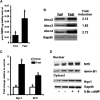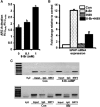Physiological Regulation of Drug Metabolism and Transport: Pregnancy, Microbiome, Inflammation, Infection, and Fasting
- PMID: 29514828
- PMCID: PMC5885931
- DOI: 10.1124/dmd.117.079905
Physiological Regulation of Drug Metabolism and Transport: Pregnancy, Microbiome, Inflammation, Infection, and Fasting
Abstract
This article is a report on a symposium entitled "Physiological Regulation of Drug Metabolism and Transport" sponsored by the American Society for Pharmacology and Experimental Therapeutics and held at the Experimental Biology 2017 meeting in Chicago, IL. The contributions of physiologic and pathophysiological regulation of drug-metabolizing enzymes and transporters to interindividual variability in drug metabolism are increasingly recognized but in many cases are not well understood. The presentations herein discuss the phenomenology, consequences, and mechanism of such regulation. CYP2D6 transgenic mice were used to provide insights into the mechanism of regulation of this enzyme in pregnancy, via hepatocyte nuclear factor 4α, small heterodimer partner, and retinoids. Regulation of intestinal and hepatic drug-processing enzymes by the intestinal microbiota via tryptophan and its metabolites was investigated. The potential impact of parasitic infections on human drug metabolism and clearance was assessed in mice infected with Schistosoma mansoni or Plasmodium chabaudi chabaudi AS, both of which produced widespread and profound effects on murine hepatic drug-metabolizing enzymes. Finally, the induction of Abcc drug efflux transporters by fasting was investigated. This was demonstrated to occur via a cAMP, protein kinase A/nuclear factor-E2-related factor 2/Sirtuin 1 pathway via antioxidant response elements on the Abcc genes.
Copyright © 2018 by The American Society for Pharmacology and Experimental Therapeutics.
Figures






Similar articles
-
High-Fat Diet Feeding Alters Expression of Hepatic Drug-Metabolizing Enzymes in Mice.Drug Metab Dispos. 2017 Jul;45(7):707-711. doi: 10.1124/dmd.117.075655. Epub 2017 Apr 25. Drug Metab Dispos. 2017. PMID: 28442500 Free PMC article.
-
Liquid Biopsy Enables Quantification of the Abundance and Interindividual Variability of Hepatic Enzymes and Transporters.Clin Pharmacol Ther. 2021 Jan;109(1):222-232. doi: 10.1002/cpt.2102. Epub 2020 Nov 25. Clin Pharmacol Ther. 2021. PMID: 33141922 Free PMC article.
-
A non-lethal malarial infection results in reduced drug metabolizing enzyme expression and drug clearance in mice.Malar J. 2019 Jul 12;18(1):234. doi: 10.1186/s12936-019-2860-5. Malar J. 2019. PMID: 31299982 Free PMC article.
-
Impact of physiological, pathological and environmental factors on the expression and activity of human cytochrome P450 2D6 and implications in precision medicine.Drug Metab Rev. 2015;47(4):470-519. doi: 10.3109/03602532.2015.1101131. Epub 2015 Nov 16. Drug Metab Rev. 2015. PMID: 26574146 Review.
-
Emerging Models of Drug Metabolism, Transporters, and Toxicity.Drug Metab Dispos. 2018 Nov;46(11):1556-1561. doi: 10.1124/dmd.118.084293. Drug Metab Dispos. 2018. PMID: 30333205 Review.
Cited by
-
Nuclear Receptor Pathways Mediating the Development of Boar Taint.Metabolites. 2022 Aug 25;12(9):785. doi: 10.3390/metabo12090785. Metabolites. 2022. PMID: 36144190 Free PMC article. Review.
-
CDK4/6 Inhibitors in Breast Cancer Treatment: Potential Interactions with Drug, Gene, and Pathophysiological Conditions.Int J Mol Sci. 2020 Sep 1;21(17):6350. doi: 10.3390/ijms21176350. Int J Mol Sci. 2020. PMID: 32883002 Free PMC article. Review.
-
Pharmacokinetics of seven major components in Aβ1-42-treated rats after oral administration of an aqueous extract of Curculiginis Rhizoma and Epimedii Folium.J Nat Med. 2025 Jan;79(1):242-257. doi: 10.1007/s11418-024-01861-8. Epub 2024 Nov 29. J Nat Med. 2025. PMID: 39612119
-
Microbiome is a functional modifier of P450 drug metabolism.Curr Pharmacol Rep. 2019 Dec;5(6):481-490. doi: 10.1007/s40495-019-00200-w. Epub 2019 Oct 19. Curr Pharmacol Rep. 2019. PMID: 33312848 Free PMC article.
-
Roles of organic anion transporter 2 and equilibrative nucleoside transporter 1 in hepatic disposition and antiviral activity of entecavir during non-pregnancy and pregnancy.Br J Pharmacol. 2019 Sep;176(17):3236-3249. doi: 10.1111/bph.14756. Epub 2019 Jul 10. Br J Pharmacol. 2019. PMID: 31166004 Free PMC article.
References
-
- Aitken AE, Richardson TA, Morgan ET. (2006) Regulation of drug-metabolizing enzymes and transporters in inflammation. Annu Rev Pharmacol Toxicol 46:123–149. - PubMed
-
- Akinyinka OO, Sowunmi A, Honeywell R, Renwick AG. (2000a) The effects of acute falciparum malaria on the disposition of caffeine and the comparison of saliva and plasma-derived pharmacokinetic parameters in adult Nigerians. Eur J Clin Pharmacol 56:159–165. - PubMed
-
- Akinyinka OO, Sowunmi A, Honeywell R, Renwick AG. (2000b) The pharmacokinetics of caffeine in Nigerian children suffering from malaria and kwashiorkor. Eur J Clin Pharmacol 56:153–158. - PubMed
-
- Babalola CP, Bolaji OO, Ogunbona FA, Sowunmi A, Walker O. (1998) Pharmacokinetics of quinine in African patients with acute falciparum malaria. Pharm World Sci 20:118–122. - PubMed
Publication types
MeSH terms
Substances
Grants and funding
LinkOut - more resources
Full Text Sources
Other Literature Sources
Research Materials

